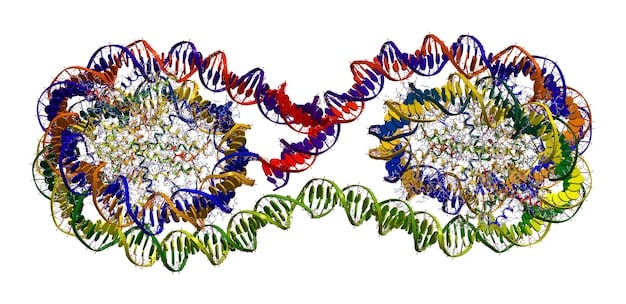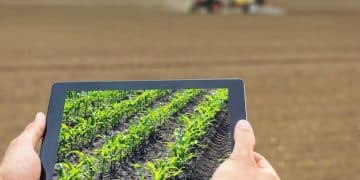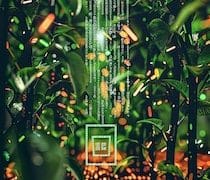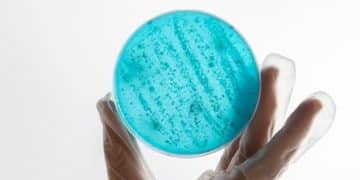Synthetic Biology: Emerging US Applications Unveiled

Synthetic biology, an interdisciplinary field that applies engineering principles to biology, is rapidly driving innovation within the United States across diverse sectors, including healthcare, agriculture, energy, and materials science, reshaping industries and offering novel solutions to complex global challenges.
The landscape of scientific innovation is constantly evolving, and few fields demonstrate this dynamism as profoundly as synthetic biology. But exactly what are the emerging applications of synthetic biology in the US? This fascinating domain, at the intersection of biology, engineering, and computer science, is poised to redefine numerous industries, promising groundbreaking solutions to some of humanity’s most pressing issues.
Revolutionizing Healthcare: Precision Medicine and Therapeutics
Synthetic biology is rapidly transforming the healthcare landscape by enabling unprecedented precision in diagnostics and therapeutics. This field allows for the engineering of biological systems with novel functions, moving beyond traditional drug discovery to create highly targeted and effective medical interventions. The potential to customize treatments at a molecular level signifies a paradigm shift in how diseases are understood and managed.
One of the most impactful emerging applications is in gene and cell therapies. Researchers in the US are designing synthetic genes and cellular circuits to correct genetic defects, enhance immune responses against cancer, and develop living therapeutics. This involves complex bioengineering to ensure that these engineered cells behave predictably and safely within the human body.
Advanced Drug Delivery Systems
Synthetic biology is enabling the creation of intelligent drug delivery systems that can precisely target diseased cells or tissues while minimizing impact on healthy ones. These systems often involve engineered viruses, bacteria, or nanoparticles that are programmed to detect specific biomarkers and release their therapeutic payload only when and where it’s needed.
- Targeted Cancer Therapies: Engineering bacteria to selectively colonize tumors and deliver anti-cancer agents, effectively shrinking tumors with fewer systemic side effects.
- Smart Diagnostics: Developing synthetic biosensors that can detect early signs of disease, such as specific protein markers or circulating tumor DNA, even before symptoms appear.
- Personalized Vaccines: Crafting novel vaccine platforms that can be rapidly customized to respond to emerging pathogens or tailor immunity for individual patients.
Beyond traditional pharmaceuticals, the ability to engineer living systems offers a new class of “biologics” that can perform complex tasks, such as producing therapeutic proteins on demand within the body or even repairing damaged tissues. These advancements represent a significant leap forward in addressing chronic and previously untreatable conditions.
The promise of synthetic biology in healthcare extends to diagnostics, where engineered biosensors can offer rapid, highly sensitive, and cost-effective detection of diseases, even at the point of care. This capability is critical for early intervention and pandemic preparedness, offering a decentralized approach to health monitoring.
The intersection with artificial intelligence and machine learning further accelerates this field, allowing for the rapid design and testing of synthetic biological components. This synergy enables researchers to explore a vast design space with unprecedented efficiency, bringing more effective and personalized medical solutions to patients faster.
Sustainable Agriculture: Enhancing Crop Resilience and Food Production
Synthetic biology is offering transformative solutions for the agricultural sector, addressing critical challenges related to food security, environmental sustainability, and resource efficiency. By engineering plants, microbes, and even biopesticides, this field promises to make farming more sustainable, productive, and resilient to changing climates.
A key area of focus involves improving crop resilience. Traditional breeding methods can be slow and limited, but synthetic biology provides tools to precisely modify plant genomes for desired traits. This includes enhancing resistance to pests, diseases, and environmental stressors like drought or salinity, which are increasingly prevalent due to climate change.
Nitrogen Fixation and Soil Health
One of the most profound applications lies in engineering nitrogen fixation. Synthetic biologists are working to transfer nitrogen-fixing capabilities, common in legumes, to other staple crops like corn and wheat. This could significantly reduce the reliance on synthetic nitrogen fertilizers, which are energy-intensive to produce and contribute to greenhouse gas emissions and water pollution.
- Engineered Microbes: Developing soil microbes that can enhance nutrient uptake by plants, improve soil structure, and protect against root pathogens, fostering healthier ecosystems.
- Bio-pesticides and Bio-herbicides: Creating environmentally friendly alternatives to chemical pesticides and herbicides, reducing chemical runoff and promoting biodiversity.
- Enhanced Nutrient Content: Designing crops with improved nutritional profiles, naturally fortified with essential vitamins and minerals, to combat malnutrition.
Beyond crop resilience, synthetic biology also aims to increase yields and optimize nutrient use efficiency. This means more food can be produced on less land with fewer inputs, a crucial factor in feeding a growing global population. The precision offered by synthetic biology minimizes off-target effects, leading to safer and more predictable outcomes in the field.
Another exciting avenue is the development of cellular agriculture, where food products like meat, dairy, and eggs are produced from cell cultures rather than traditional animal farming. This not only offers a more sustainable production method but also reduces the environmental footprint associated with livestock, including land use and greenhouse gas emissions.
The potential for synthetic biology to create “designer foods” with specific nutritional benefits or extended shelf lives is also being explored. Imagine a tomato engineered to produce higher levels of antioxidants or a banana with natural resistance to blight, requiring fewer interventions. These innovations could revolutionize supply chains and consumer access to healthy food.
Advancing Bioenergy and Biomanufacturing: A Greener Future
The quest for sustainable energy and manufacturing processes is significantly boosted by synthetic biology. This field offers innovative pathways to produce biofuels, biomaterials, and chemicals from renewable resources, moving away from a reliance on fossil fuels and traditional chemical synthesis methods that often generate considerable waste.
In bioenergy, synthetic biologists are engineering microorganisms, particularly algae and bacteria, to efficiently convert sunlight or biomass into biofuels like ethanol, butanol, and even jet fuel. This involves optimizing metabolic pathways to maximize fuel yield and developing robust strains that can thrive in large-scale bioreactors.
Sustainable Chemical Production

Biomanufacturing, also known as industrial biotechnology, utilizes engineered microbes as tiny factories to produce a vast array of high-value chemicals, enzymes, and materials. This process often operates at lower temperatures and pressures than traditional chemical synthesis, making it inherently more energy-efficient and reducing the need for harsh chemicals.
- Bio-based Plastics: Producing biodegradable plastics from renewable feedstocks, offering a sustainable alternative to petroleum-based plastics and addressing the plastic pollution crisis.
- Specialty Chemicals: Manufacturing complex chemicals, pharmaceuticals, and fragrances that are difficult or expensive to synthesize chemically, using microbial fermentation processes.
- Carbon Capture and Utilization: Engineering microbes to consume CO2 as a feedstock, converting atmospheric carbon into valuable products, contributing to carbon sequestration efforts.
The shift towards a bio-based economy facilitated by synthetic biology is not just about producing new forms of energy or materials; it’s about fundamentally redesigning industrial processes to be circular and regenerative. This approach dramatically reduces waste, minimizes environmental impact, and fosters a more resilient economic infrastructure.
Companies in the US are actively investing in scaling up biomanufacturing capabilities, recognizing the significant economic and environmental benefits. From textile dyes to cosmetics ingredients, products once derived from petroleum are increasingly being produced through biological routes, underscoring the versatility of engineered microbes.
The development of economically viable cellulosic biofuels, for example, remains a grand challenge, but synthetic biology is making strides by improving the efficiency of enzymes that break down tough plant materials. This could unlock vast untapped resources for renewable energy, lessening dependence on food crops for fuel production.
Environmental Remediation and Conservation: Healing Our Planet
Synthetic biology presents powerful tools for addressing pressing environmental challenges, from pollution cleanup to biodiversity conservation. By engineering microorganisms, researchers are developing novel solutions to remediate contaminated sites, monitor environmental health, and even prevent ecological damage.
A significant application lies in bioremediation, where engineered bacteria are deployed to break down pollutants in soil and water. These “living machines” can be programmed to target specific contaminants like heavy metals, pesticides, or petroleum hydrocarbons, converting them into less harmful substances or facilitating their removal.
Advanced Biosensors for Environmental Monitoring
Synthetic biology is enabling the creation of highly sensitive and specific biosensors for environmental monitoring. These engineered organisms can detect minute traces of pollutants, pathogens, or ecological changes in real-time, providing early warnings and informed decision-making for environmental protection.
- Plastic Degradation: Engineering enzymes and microbes capable of breaking down persistent plastics, such as PET, offering a biological solution to plastic waste accumulation.
- Oil Spill Cleanup: Developing bacteria programmed to efficiently degrade crude oil components in marine environments, enhancing the effectiveness of oil spill responses.
- Detection of Contaminants: Creating whole-cell biosensors that change color or produce a fluorescent signal in the presence of specific toxins in water supplies or agricultural fields.
Beyond remediation, synthetic biology is also being explored for conservation efforts. This includes projects aimed at de-extincting species, although highly controversial, and efforts to bolster endangered populations by enhancing their genetic resilience to diseases or environmental shifts. The ethical implications, however, are rigorously debated.
The ability to precisely manipulate genetic material opens avenues for designing organisms that can perform complex environmental tasks that traditional chemical or mechanical methods cannot achieve efficiently. This includes recovering valuable resources from waste streams, turning pollution into profit.
For instance, researchers are investigating engineering microbes to capture carbon dioxide directly from industrial emissions or even the atmosphere, and then converting it into useful products like fuels or chemicals, effectively turning waste into a resource. This innovative approach holds immense potential for mitigating climate change impacts.
Advanced Materials Science: Innovations in Design and Functionality
Synthetic biology is bridging the gap between biology and materials science, leading to the development of novel materials with unprecedented properties and functionalities. This field leverages biological processes to create materials that are self-assembling, self-repairing, responsive to external stimuli, and often produced with a significantly lower environmental footprint than traditional manufacturing.
One of the core principles is biofabrication, where living cells or their components are used as building blocks to create complex structures. This allows for the precise control over molecular architecture, leading to materials with tailored strength, flexibility, conductivity, or other desired attributes.
Living Materials and Bio-inspiration

The natural world is replete with examples of highly optimized materials, such as spider silk or abalone shell. Synthetic biology seeks to understand the genetic blueprints behind these materials and then engineer microorganisms or cells to produce them sustainably. Beyond replicating natural materials, the goal is often to create entirely new “living materials” that can sense, adapt, or even grow.
- Self-Healing Concrete: Incorporating bacteria into concrete that can produce calcium carbonate to fill cracks, extending the lifespan of infrastructure and reducing maintenance costs.
- Biological Composites: Developing lightweight and strong composites by combining engineered proteins or cellulose fibers with synthetic polymers, suitable for aerospace and automotive industries.
- Bioprinted Organs and Tissues: Advancing 3D bioprinting techniques to create functional human tissues and organs for transplantation, revolutionizing regenerative medicine.
The environmental benefit of bio-fabricated materials is substantial. Many traditional material production processes are energy-intensive and rely on finite resources. Synthetic biology offers a pathway to produce materials from renewable feedstocks, often using benign aqueous environments, thus reducing energy consumption and hazardous waste generation.
Furthermore, the concept of “programing” materials to respond to their environment opens up a new realm of smart materials. Imagine fabrics that can sense and respond to temperature changes, or packaging that indicates food spoilage through a color change. These responsive materials have applications across consumer goods, medical devices, and industrial sensors.
The convergence with nanotechnology further amplifies the potential of synthetic biology in materials science. Researchers are engineering biological systems to self-assemble nanoparticles or nanowires with specific electronic or optical properties, paving the way for next-generation electronics and quantum computing elements.
Ethical and Regulatory Considerations: Navigating the Future
As synthetic biology continues to advance, it brings with it profound ethical, legal, and societal implications that require careful consideration. The ability to design and create novel biological systems necessitates robust oversight and open public dialogue to ensure responsible innovation and prevent unintended consequences. The US is actively engaged in developing frameworks to address these challenges.
Key ethical concerns revolve around the potential for dual-use applications (beneficial versus harmful uses), the impact on biodiversity and ecosystems if engineered organisms escape into the environment, and questions of human enhancement or genetic manipulation. Ensuring public trust and engagement is paramount for the long-term success and acceptance of this field.
Navigating the Regulatory Landscape
The regulatory landscape for synthetic biology in the US is complex, often relying on existing frameworks developed for biotechnology, pharmaceuticals, and chemicals. Agencies like the FDA, EPA, and USDA play roles depending on the specific application, but a truly comprehensive and harmonized approach for this rapidly evolving field is still being refined.
- Risk Assessment: Developing robust methodologies to assess the ecological, health, and societal risks associated with engineered organisms and products, including containment strategies.
- Public Engagement: Fostering transparent dialogue with the public, policymakers, and stakeholders to address concerns, build understanding, and ensure societal values guide research and development.
- Biosafety and Biosecurity: Implementing strict laboratory containment measures and developing strategies to prevent the misuse of synthetic biology tools, particularly concerning biological weapons.
The concept of “responsible innovation” is central to the ethical development of synthetic biology. This involves not only anticipating potential risks but also actively designing technologies with societal benefit and sustainability in mind from the outset. This proactive approach helps to mitigate unforeseen negative impacts.
Intellectual property rights also present a complex challenge in a field built on genetic sequences and biological processes. Balancing the need for innovation incentives with ensuring broad access to these technologies, especially for humanitarian applications, is an ongoing debate.
Ultimately, navigating the future of synthetic biology in the US requires a multi-faceted approach that combines scientific rigor, robust regulatory frameworks, continuous ethical reflection, and proactive public engagement. By addressing these considerations thoughtfully, the US can harness the immense potential of synthetic biology while ensuring it serves the greater good.
The development of clear and consistent international guidelines is also crucial, given the global nature of scientific research and potential transboundary impacts. Collaborative efforts among nations are essential to establish shared principles and practices for the safe and ethical advancement of synthetic biology worldwide, ensuring its benefits are realized responsibly.
Economic Impact and Innovation Ecosystem: Fueling Growth
The emerging applications of synthetic biology in the US are not just scientific breakthroughs; they are also powerful drivers of economic growth and job creation. The burgeoning synthetic biology industry is catalyzing significant investment, fostering innovation hubs, and creating a diverse array of high-skilled jobs across various sectors.
Venture capital and private equity firms are increasingly recognizing the transformative potential of synthetic biology, pouring substantial funds into startups and established companies alike. This investment fuels research and development, facilitates the scaling up of biomanufacturing processes, and helps bring novel products to market.
Hubs of Innovation and Collaboration
The US innovation ecosystem, particularly in regions like Boston, San Francisco Bay Area, and San Diego, has become a global leader in synthetic biology. These hubs benefit from a high concentration of leading research universities, pharmaceutical and biotech companies, and a robust startup culture, fostering extensive collaboration. Public-private partnerships are also key to translating foundational research into commercial applications.
- Startup Proliferation: A vibrant landscape of new companies is emerging, focusing on specific applications from sustainable materials to cellular agriculture, driving rapid commercialization.
- Talent Development: Universities and vocational programs are expanding to train a new generation of scientists, engineers, and technicians skilled in synthetic biology, meeting growing industry demand.
- Investment Growth: Record levels of investment are flowing into the sector, indicating strong confidence in its future potential and the scalability of its applications.
The economic impact extends beyond direct job creation within the synthetic biology companies themselves. It creates a ripple effect throughout the economy, stimulating demand for specialized equipment, bioinformatics services, and raw materials. Furthermore, the products of synthetic biology, such as advanced biofuels or precision medicines, can generate significant savings and efficiencies in other industries.
The US government also plays a significant role through funding agencies like the National Institutes of Health (NIH), the Department of Energy (DOE), and the Defense Advanced Research Projects Agency (DARPA). These investments support foundational research that underpins many commercial applications and addresses strategic national interests.
Moreover, the focus on sustainable and bio-based products aligns with global efforts to build a greener economy, positioning the US at the forefront of this critical transition. This strategic alignment offers long-term competitive advantages and enhances national security by reducing reliance on vulnerable supply chains for crucial materials and energy resources.
The synergistic relationship between academic research, industrial innovation, and governmental support characterizes the dynamic ecosystem propelling synthetic biology forward in the US. This collaboration is essential for overcoming complex scientific challenges and ensuring that the economic benefits are widely realized, fostering a robust and resilient bioeconomy.
| Key Area | Brief Description |
|---|---|
| 🏥 Healthcare Revolution | Developing precision medicines, advanced diagnostics, and cell therapies. |
| 🌱 Sustainable Agriculture | Enhancing crop resilience, improving nutrient use, and creating bio-pesticides. |
| ⚡ Green Energy & Mfg. | Producing biofuels, sustainable chemicals, and bio-based plastics. |
| ♻️ Environmental Solutions | Bioremediation, advanced biosensors, and carbon capture technologies. |
Frequently Asked Questions About Synthetic Biology
▼
Synthetic biology is an interdisciplinary field that applies engineering principles to biology. It involves designing and constructing new biological parts, devices, and systems, as well as redesigning existing natural biological systems for useful purposes. This field merges biology with engineering, computer science, and other disciplines to create novel biological functions not found in nature.
▼
While often used interchangeably, synthetic biology is a broader field than genetic engineering. Genetic engineering typically involves transferring existing genes between organisms or modifying individual genes. Synthetic biology, however, focuses on designing and building new biological components and systems from scratch, or extensively re-engineering existing ones, much like how engineers build complex machines from standardized parts.
▼
In the US, synthetic biology is impacting diverse sectors including healthcare (precision medicine, drug delivery), agriculture (crop resilience, sustainable food production), energy (biofuels), manufacturing (biomaterials, specialty chemicals), and environmental remediation (pollution cleanup, biosensors). These applications offer innovative solutions to address complex societal and environmental challenges, driving economic growth.
▼
Key ethical concerns include potential dual-use applications (beneficial vs. harmful), the impact of engineered organisms on natural ecosystems if released, and questions around human enhancement or genetic manipulation. There are also debates about intellectual property and equitable access to these powerful technologies. Responsible innovation and public engagement are crucial to address these concerns.
▼
The US government provides significant funding through agencies like NIH, DOE, and DARPA for fundamental research and strategic applications. Additionally, a robust innovation ecosystem, particularly in biotech hubs, attracts substantial venture capital and fosters private-sector investment in startups and established companies. This collaborative environment accelerates technology translation and commercialization.
Conclusion: Charting a Course for the Bio-Revolution
The dynamic and multifaceted field of synthetic biology is undeniably charting a course for a bio-revolution, with the United States at its forefront. From reimagining healthcare with precision therapies and advanced diagnostics to fostering sustainable agriculture and developing greener industrial processes, its applications are expansive and transformative. While challenges related to ethics, regulation, and scalability persist, the concerted efforts of researchers, policymakers, and industry leaders are driving responsible innovation forward. As the US continues to invest in scientific talent and infrastructure, synthetic biology stands poised to deliver groundbreaking solutions that address critical global challenges, promising a future shaped by biological engineering.





